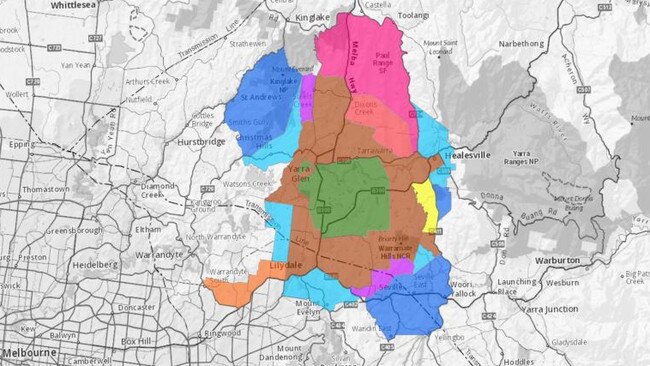Yarra Valley, Nillumbik, Maroondah and Manningham in wine bug infection zone
The future of the Yarra Valley wine industry hangs in the balance as growers struggle to contain the spread of a hard-to-detect deadly insect attacking vines, causing what could be $1 billion worth of damage. And the fight is on to stop it spreading.

Outer East
Don't miss out on the headlines from Outer East. Followed categories will be added to My News.
A hard-to-detect, root-eating bug is spreading across the Yarra Valley.
Growers across the region’s 2500ha of vineyards are struggling phylloxera, a deadly insect attacking vines, with predictions the damage bill could pass $1 billion.
Since 2006, when phylloxera was first detected in the region, the boundaries around the Department of Agriculture’s biosecurity blanket — the Maroondah Phylloxera Infested Zone — have increased and now include vineyards in the Yarra Ranges, Nillumbik, Manningham and Maroondah.

According to Vine Health Australia the pest, similar to an aphid, destroys grapevines by feeding on its roots.
An infected vine will die within six years and there is no treatment to get rid of the bug.
The only way to remove the pest from the vineyard is to replant vines using plants grafted with American rootstock that has grown resistant to the bug — a solution that costs about $60,000 a hectare.
Phylloxera can be spread easily through the transfer of soil either on someone’s shoes or clothes, or from machinery that has not been properly disinfested.
Yarra Valley Wine Growers Association president and Hoddles Creek Estate owner, Franco D’Anna, said the organisation was working closely with the State Government to stop the spread.

“The Yarra Valley has 2500ha and we think 1500ha is infested with phylloxera,” Mr D’Anna said.
“If we don’t start replanting, the industry could be 50 per cent of what is in now in 10 years.
“The cost to our industry could be $1 billion.”
While those in the association believe about 50 wineries have been hit, it could take up to three years to discover a vineyard has been infected.
Mr D’Anna said at present only about 14 per cent of vines in the region had been replaced with resistant root stock.
He said it was expensive to buy the phylloxera resistant root stock and there was at least a two-year wait on US root stock.
“You have the cost of replanting and the it will be three years until you get a crop, so you’re losing three years of income,” Mr D’Anna said.

He said phylloxera was an asexual insect — able to reproduce on its own — that can only be seen through a microscope.
“Vine roots can go down 6m to 7pm underground so you cannot see the insects,” Mr D’Anna said.
He said with the increased use of contractors in the industry it was difficult to make sure there was no transfer of the infection to other vineyards.
Mr D’Anna said the association’s aim was to slow the growth of phylloxera in the region and prevent it from infecting other wine growing regions such as Mornington and South Australia.
“We are one of the first tourist regions in Australia to have phylloxera discovered and it’s close in proximity to Mornington,” Mr D’Anna said.
“You have tourists going to the Yarra one day and then Mornington the next.”
MORE: BUSHFIRE INQUIRY COMES TO HEALESVILLE
HOW KNOX MUM LOST THREE FRIENDS TO DOMESTIC VIOLENCE
PUSH TO FIX YARRA RANGES’ DEER PROBLEM FALLS ON DEAF EARS
Yarra Ranges Cr Jim Child said the council had been briefed on the phylloxera situation and was concerned about the potential cost to the wine industry.
Victoria’s chief plant health officer Rosa Crnov said all wine grape growers were reminded they played a vital role in ensuring the health of their produce.
“Agriculture Victoria is working with Yarra Valley wine grape growers to promote biosecurity practices to mitigate the threat of phylloxera, and limit its spread,” Ms Crnov said.
“Growers should remind visitors to use footbaths before entering vineyards, disinfect equipment, machinery and clothing property, and park vehicles outside of vineyards.”
